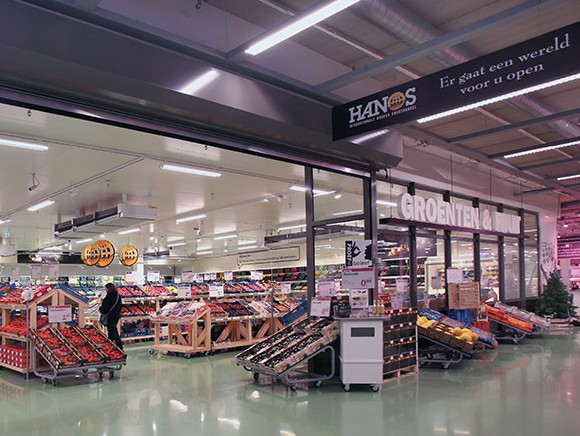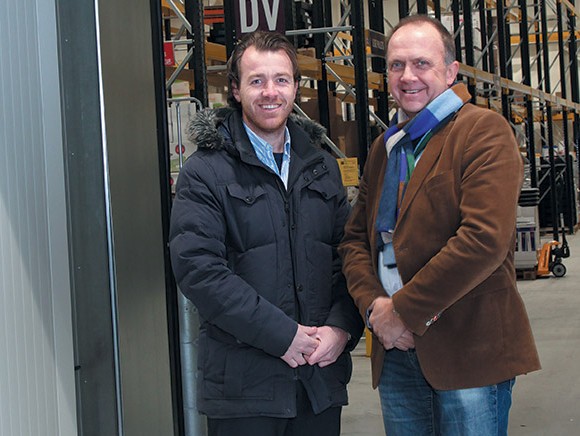
If you want to separate two areas with different climates, your first thought will probably be to install a wall and a door. But what if you’re a wholesaler with fresh departments that must be easily accessible and also inviting? Or if condensation – or even ice – forms around the door, including on the floor? In that case, an air curtain is the solution.
“In the cold storage unit at our store in Groningen there was so much condensation that water was dripping down the windows,” says Rob Kuijpers, Facilities Manager at wholesaler HANOS. The company was already working with Biddle, manufacturer and supplier of climate solutions, where Ron Jongenelen is Advisor Industry/Cold Stores. Kuijpers continues: “So I said to Ron: ‘You should install one of those air curtains there.’ But closer investigation revealed that the open lobster trays were causing the condensation so the problem lay elsewhere.” According to Kuijpers, that typifies the relationship between him and Biddle: “They aren’t box-shifters; they really take responsibility for ensuring that a solution works.”
The collaboration started three years ago when Jongenelen solved a problem at the wholesale store in Haarlem where a sliding door separated the freezer from the (relatively warm) packaging hall. This led to the formation of ice on the floor. Kuijpers: “It became slippery and dangerous, but an air curtain has put an end to that now.”
On 9 November 2015 the food wholesaler opened a brand-new store in Delft. Biddle supplied a number of air curtains to enable different temperatures to be maintained in the chilled departments (dairy, fresh produce) than in the rest of the store. But the extreme temperature differences in the passageway between the cold store and the freezer, located at the back of the building, called for a more heavyweight solution: the MAT Hybrid – the newest and most advanced air curtain in the supplier’s portfolio. “It’s a brand-new innovation,” says Jongenelen with pride, “because this air curtain first utilises the waste heat and only uses additional electricity when it’s necessary to heat the air in the air stream.”
When a temperature difference occurs between two zones, an air curtain separates the climates by creating an air flow. At the entrance to retail stores this is called a comfort curtain and in cold storage environments it’s called a chilled room air curtain.
Jongenelen: “An air curtain saves energy because it prevents the exchange of air between two different areas. With a normal door there is always some ‘leakage’ of air into the other climate zone, which then has to be cooled or heated, plus condensation or ice can form resulting in slipperiness. Another advantage of the air curtain is that it does not form a visible barrier. You can see through it, which is better in terms of both safety and accessibility.” For Kuijpers – who prefers to call it an air wall than an air curtain, because a wall reaches the floor and physically separates two zones – the accessibility aspect is essential. “If we were to turn our dairy department into an enclosed area with a door, people would be less inclined to step inside. An open area is more inviting, which means that we sell more products.”
The manufacturer and supplier of climate solutions pushes back technological boundaries to create the perfect air curtain. For example, air curtains can be programmed to operate fully automatically. Jongenelen: “The system itself adjusts the temperature of the air stream and the amount of air based on the indoor and outdoor temperature.”
‘The floor became slippery and dangerous due to ice formation’
The supplier holds the patent to some parts of the technology, such as for expelling the air. “The volume of air expelled is low but effective. We use less air plus, in contrast to turbulent air, the stream of air is less erratic. Our technology creates a more constant – i.e. laminar – air flow which consumes less energy, is quieter and extends right down to the floor.”
The supplier’s showpiece is the MAT Hybrid. At HANOS in Delft this system is installed in the transition between the cold storage chamber (approx. 2 degrees Celsius) and the freezer (approx. minus 25 degrees Celsius). What makes this system so unique? Jongenelen: “In the MAT, the air stream comprises three flows, each with a different temperature: a frozen flow with air drawn in from the freezer, a cold flow of air extracted from the cold storage chamber and a warm flow in between which acts as a buffer. That might seem contradictory but the two cold flows would otherwise create a mist, so we prevent that by adding warm air. Electricity would normally be required to heat the air, but this hybrid system first utilises the waste heat from the CO2 machine.”

An air curtain is much more expensive than a door, isn’t it? Jongenelen: “In terms of the purchase price it is, but not if you consider the total cost of ownership. An air curtain enables you to save energy compared with an open door, plus you create a safer environment because you prevent the formation of condensation and ice and – as Rob said – you boost product sales. The same holds true for a retail store; a closed door isn’t inviting, whereas an open space is.” However, the company’s aim is not simply to sell as many air curtains as possible but rather to build good customer relationships. Jongenelen: “We work with each customer beforehand to explore whether climate separation makes sense and, if so, which type is most suitable. We can then make a rough estimate of whether the payback period will be a year, for example, or perhaps two. This all depends on the individual situation: how big are the temperature differences, how wide is the gap, and how often and for how long would a door be open? Each doorway calls for tailor-made advice. There’s no point in incurring unnecessary costs if a large system isn’t needed. We supply turnkey systems and we provide advice but above all we ensure that our customers benefit from long-term solutions.”
Photo: Ron Jongenelen (left) and Rob Kuijpers
Source: © Biddle